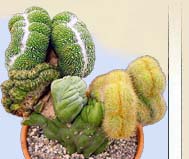Indoor
Floriculture

Leafy succulents
by Peter Lapshin

Cacti Library
'Cultivar' (V.Kalishev)

Moscow
Succulent Society

Moscow Indoor
Plant Club

Travels, nature,
botanical gardens

About Episcia
(Gesneriaceae)
 |
 |
CULTIVAR / КУЛЬТИВАР e-Magazine about exotic forms of Cactaceae ENGLISH / RUS-(Win1251) | |||
|
|
|

|
Eugene B. Erokhin, IOS member
Cactus collection of Nikitsky Botanical Garden has many unique specimens, including four large plants of Echinocactus grusonii , which are about 45 years old and 65 cm (25 in) in diameter. These were raised from seed (Photo 1). The plants start blooming in July and keep their yellow flowers open till mid-September. The flowers are bell-shaped with narrow petals, 4-5 cm (2 in) in size. The plants flowered for the first time in 1980. Since then, tens of thousand seedlings have been grown and commercialized from seeds obtained as a result of artificial pollination of these cacti. One of the collection's highlights is a big Espostoa lanata, more than 2 meters (6.5 ft) tall, which was obtained as a seedling from Georgy G. Volsky of St. Petersburg (Russia) in 1975. It formed cephalium in 1993 and flowered for the first time in 1997, after being transferred to the new exhibit greenhouse. Now this is a tall plant with chandelier-branching stem (Photo 2). This plant originates from south of Ecuador to central Peru at the elevations of up to 2,500 m (8,300 ft.) above the sea level. Stems are covered with dense delicate white hair. White funnelform flowers are 4-5 cm (about 2 in) in diameter, emerge from cephalium and stay open for only one night.
A number of large cacti flowered for the first time in our collection in 1996, after being transplanted from the old nursery to the new exhibit greenhouse: Marginatocereus marginatus, Rooksbya euphorbioides, Neobuxbaumia polylopha, Trichocereus chilensis, and others. Marginatocereus marginatus is a big tree-like plant, having stems up to 3 m (10 ft) high and 30 cm (1 ft) in diameter. It branches abundantly at the base level with dark green stems. Natural habitat is central and southern Mexico. In Nikitsky Garden's collection this plant opens flowers in the morning, between 5 and 10 am, contrary to some reports mentioning nocturnal bloom. Flowers are white with yellow-green outer petals, funnelform, 5 cm (2 in) long and 3 cm (1.25 in) in diameter. Floral tube is covered with sparse yellowish scales. In 1997 we observed Marginatocereus marginatus flowering in early May. Total number of flowers was about 340. Flowers are borne at the south side of the stem, mainly on one of the strips of densely floccose areoles. Despite of the generous blooming, we observed very poor bearing – only two fruits. Seeds are flattened, shining black, scanty, only 7-9 per fruit. Rooksbya euphorbioides has a light green columnar stem, 3-4 m (10-13 ft) high, somewhat widening toward the tip, not branching. All five plants in the collection flowered profusely in the second half of July 1997. Fruits are greenish-yellow, elongated, covered with scales, with flat knobs, typically split longitudinally. Seeds are light brown, glossy, numerous (150 to 300 per fruit). Distribution: from Tamaulipas to Puebla and Oaxaca, Mexico. Neobuxbaumia polylopha – stem is light green, 5-7 m (17-23 ft) high, 40 cm (16 in) in diameter, unbranching. All five plants blossom well and regularly produce fruits. Natural distribution: Hidalgo, Mexico. All mentioned species successfully flower and bear fruits in the environment of the cactus greenhouse of Nikitsky Botanical Garden. They don't require any sophisticated care and can be recommended for winter gardens and halls, may be potted separately or arranged with other plants. More details about the collected species you can find on the website "Cacti Greenhouse" of the Nikita Botanical Garden. The site has photographs of more than two hundred of the most interesting succulent species from the Garden collection and also landscape photos of parks of Nikita Botanical Garden.
|
| Cultivar e-magazin: Copyright (c) by Valery Kalishev, Chelyabinsk, Russia, since 2000. Design and hosting by Peter Lapshin, since 2002. Contacts: Peter Lapshin |
|
|